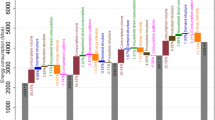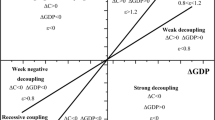Abstract
The decoupling analysis has become an important tool to explore whether an economy is becoming less dependent on energy resources. Based on the LMDI (Log-Mean Divisia Index) method, this paper defines a new decoupling indicator (ZM decoupling indicator), which depicts the relationship between energy saving influence factors and energy driving influence factors. Then, the ZM decoupling indicator is utilized to explore the state of decoupling between economic growth and energy consumption in China. The main results are as follows: (1) The gap of economic structure between the secondary industry and tertiary industry gradually narrowed during the study period 1991–2012. (2) The economic growth effect (\(\Delta E_{\text{g}}^{t}\)) was the critical factor in the growth of the final energy consumption in China. However, the energy intensity effect (\(\Delta E_{\text{ei}}^{t}\)) played an important role in decreasing the final energy consumption. (3) Based on the definition of ZM decoupling indicator, only four decoupling statuses occurred in China over the study period: weak decoupling, expansive coupling, strong decoupling, and expansive negative decoupling.


Similar content being viewed by others
References
Ang BW (2004) Decomposition analysis for policy making in energy: which is the preferred method. Energy Policy 32:1131–1139
Ang BW, Liu N (2007) Handling zero values in the logarithmic mean Divisia index decomposition approach. Energy Policy 35:238–246
BP (British Petroleum) (2012). BP statistical review of world energy June 2012. www.bp.com
CESY (China Energy Statistical Yearbook) (1991–1996, 1997–1999, 2000–2002, 2003, 2004. 2005, 2006, 2007, 2008, 2009, 2010, 2011, 2012) National Bureau of Statistics of China, National Development and Reform Commission
Climent F, Pardo A (2007) Decoupling factors on the energy-output linkage: the Spanish case. Energy Policy 35:522–528
CSY (China Statistical Yearbook) (2014) National Bureau of Statistics of China
Diakoulaki D, Mandaraka M (2007) Decomposition analysis for assessing the progress in decoupling industrial growth from CO2 emissions in the EU manufacturing sector. Energy Econ 29:636–664
Freitas LC, Kaneko S (2011) Decomposing the decoupling of CO2 emissions and economic growth in Brazil. Ecol Econ 70:1459–1469
IPCC (1995) Greenhouse gas inventory: IPCC guidelines for national greenhouse gas inventories. United Kingdom Meteorological Office, Bracknell
Juknys R (2003) Transition period in Lithuania-do we move to sustainability. J Environ Res Eng Manag 4(26):4–9
OECD (Organization for Economic Co-operation and Development) (2010) Indicators to measure decoupling of environmental pressure from economic growth. sustainable development. SG/SD (2002) 1/Final. Website: http://www.olis.oecd.org/olis/2002doc.nsf/LinkTo/sg-sd(2002)1-final. Accessed 28 Aug
Ren SG, Hu Z (2012) Effects of decoupling of carbon dioxide emission by Chinese nonferrous metals industry. Energy Policy 43:407–414
Tapio P (2005) Towards a theory of decoupling: degrees of decoupling in the EU and the case of road traffic in Finland between 1970 and 2001. Transp Policy 12:137–151
Von Weizsäcker EU (1989) Erdpolitik: Ökologische Realpolitik an der Schwelle zum Jahrhundert der Umwelt. Wissenschaftliche Buchgesellschaft, Darmstadt, p 295
Zhang ZX (2000) Decoupling China’s carbon emissions increase from economic growth: an economic analysis and policy implications. World Dev 28:739–752
Zhang M, Guo FY (2013) Analysis of rural residential commercial energy consumption in China. Energy 52:222–229
Zhang M, Wang WW (2013a) Decouple indicators on the CO2 emission-economic growth linkage: the Jiangsu Province case. Ecol Indic 32:239–244
Zhang M, Wang WW (2013b) Decoupling analysis of electricity consumption from economic growth in China. J Energy South Afr 24:57–66
Zhang M, Liu X, Wang WW, Zhou M (2013) Decomposition analysis of CO2 emissions from electricity generation in China. Energy Policy 52:159–165
Zhang M, Song Y, Su B, Sun XM (2015) Decomposing the decoupling indicator between the economic growth and energy consumption in China. Energ Effic 8:1231–1239
Acknowledgements
The authors gratefully acknowledge the financial support from the Fundamental Research Funds for the Central Universities (2017XKQY018). We also would like to thank the anonymous referees for their helpful suggestions and corrections on the earlier draft of our paper, and upon which we have improved the content.
Author information
Authors and Affiliations
Corresponding author
Rights and permissions
About this article
Cite this article
Song, Y., Zhang, M. Using a new decoupling indicator (ZM decoupling indicator) to study the relationship between the economic growth and energy consumption in China. Nat Hazards 88, 1013–1022 (2017). https://doi.org/10.1007/s11069-017-2903-6
Received:
Accepted:
Published:
Issue Date:
DOI: https://doi.org/10.1007/s11069-017-2903-6




